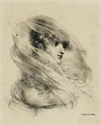
19th, 20th & 21st Century Fine Prints
707-546-7352 · fax 707-546-7924 · web: www.annexgalleries.com · email: artannex@aol.com
Jean-Baptiste Isabey Biography
Jean-Baptiste Isabey
French
1767–1855
Biography
Jean-Baptiste Isabey was born in Nancy, Meurhte-et-Moselle, France on April 11,1767, the son of a merchant. He studied with architecture and decoration with Girardet and landscape with Claudet in Nancy. At the age of 19, in 1786, he went up to Paris, with a letter of recommendation addressed to Dumont, the Lorraine artist and 'Premier peintre' to the Queen. He made his living painting the covers for snuff boxes and the ornamentation for buttons on formal clothing, responding to the demand of the times. Introduced at court in Versailles he became of pupil of Jacques-Louis David (1748-1825) in Paris in 1788. He went on to be one of the first painters to work in the relatively new medium of stone lithography, specializing in portraits.
In 1791 Isabey married Jeanne Laurice de Salienne. After a loss of patrons, a result of the French revolution, Isabey managed to rebuild himself a client base through his friendship with J-L David, exhibiting many miniatures at the Paris Salon in 1793.
During the Directory period he frequented drawing rooms of Mme Tallien, Mme de Stael and Mme Récamier, becoming a friend both of the young general Napolon Bonaparte and his wife Josephine – he was later to be appointed drawing master to Josephine's children Hortense and Eugène
J-B Isabey received one of his first portrait commissions from Marie Antoinette (1774-1792) and enjoyed the patronage of both Napoleon I and Louis Philippe.
Despite his original connections with the monarchy, Isabey created 228 portraits of deputies for a work on the Legislative Assembly during the French Revolution. Patronized by Napoleon and Joséphine, he arranged the ceremonies of their coronation and prepared 32 drawings, intended as an official commemoration of the event. He had an immense success at the Salon of 1820 with Isabey’s Boat, a drawing of himself and his family. During the reign of King Louis-Philippe (1830–48), he directed the artists’ studio at the Sèvres porcelain factory.
Less known than the portraits are Isabey’s caricatures of many famous European politicians of the first half of the 19th century. Though Isabey was primarily a portrait painter he was in contact with all the great continental political personalities of the first half of the 19th century, and he caricatured many of them privately. Most of the caricatures were not published, but they had an effect among artists of the time, as did the satirical prints of Francisco de Goya.
He was awarded the Légion d'honneur in 1825. After the death of his wife Jeanne in 1829, he remarried, this time to one of his pupils, Eugénie Maystre, with whom he had two children (Henri 1830-1834 and Henriette 1837-1881). In 1837 Louis-Philippe appointed him 'Deputy Curator of the Royal Museums'.
Jean-Baptiste Isabey died in Paris, France on April 18, 1855 after Napoleon III made him Commander of the Légion d'honneur. he was buried in Père Lachaise cemetery.
His son, and student, was the noted genre painter and printmaker Louis-Gabriel-Eugène Isabey (1803-86). His graphic oeuvre was catalogued by Germain Hediard in 1906 and E.de Basily and Mme. Callimaki in 1909.


